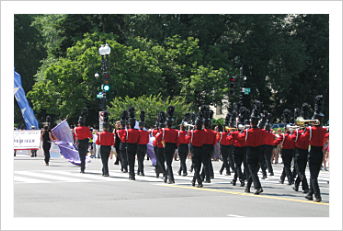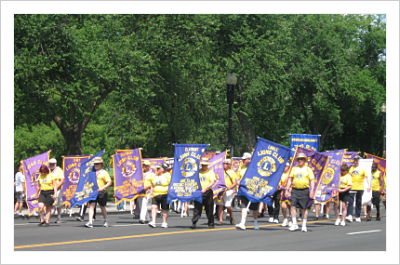I told myself repeatedly over the few days before I rode public transportation to GALA Theatre that Friday night, I would not be intimidated by fear or a number.
I will ride and I will not drive, I said firmly.
And so I did.
The getting there was the easy part, on Metro from Tysons and then up 14th Street on Bus #52 from the McPherson Square station.
At GALA I saw a wonderful flamenco performance, and wanted to stay for the Spanish Embassy reception afterwards, but the back of my mind rumbled with the gnawing realization that public transportation awaited me at 10:30 at night in the edgy neighborhood.
I skipped the reception at the end of the show and left the theatre and crossed 14th to wait on a bus. Nearby, lights on a police car blinked.
I was happy to see the police car and thankful for the upcoming DC mayoral election, for, with the uptick in crime, Mayor Bowser just might have instructed the police to have “all hands on deck.” I hoped so.
At the corner only seconds passed before I was joined by another rider, a woman ranting and raving about Taco Bell: “I didn’t get fired!” she exclaimed. “I quit!” Over and over. She walked back and forth in front of me like a caged beast.
OK, I said to myself silently; I understand. But, where is the bus?
There it was, ambling down the street at last, although only a few moments had passed since I had begun my wait.
We boarded, and I took a seat opposite the rear exit in case a sudden escape became necessary. The woman sat at the front and continued her loud rants.
Another passenger sat across the aisle from her and pulled out a liquor bottle from his jacket pocket and offered her a drink.
“I don’t need that!” she bellowed.
We passed the Taco Bell a few seconds later, and she pointed to it and screeched: “It’s gonna kill someone!”
I tried to look ahead and out the windows, to avoid "engagement" and locking eyes with anyone.
When you ride a bus at night, you expect these outbursts. They are common.
The last three times I went to Mosaic Theater on H Street (pre-covid) the police were always involved in some form or fashion with activities on the free trolley car.
But that was then, and this was now.
14th seemed loaded with police cars every few blocks with red lights blinking on their car tops. I was grateful. Who wants to "defund the police"?
The bus continued its ramble down the street, stopping and starting to let passengers off and on, while the man and the woman continued their exchange which escalated quickly, and he pulled out a cigarette.
Was he going to light up on the bus? What would the driver do? But, behind his hard plastic window and from all I could see, the driver was oblivious to the action behind him, likely used to it all.
When the man called the woman the “n” word (he was black, too), the woman became enraged. Their conversation grew louder, more heated and indignant until she challenged the man to a fight.
On the bus?
They stood in the aisleway, apart, weaving back and forth in time with the bus’s motions and, began to dance the fighter's dance, yelling their words of conflict and hate.
This performance was more than the flamenco, and it was free!
But, at the flamenco, I wasn't afraid, like I was on the bus, sensing danger since I was within arm’s reach of the two fighters who moved in a semi-circle gnarling at each other, like they were in a boxing ring.
Where was McPherson Square?
I decided to get off at the next bus stop wherever it might be, and the woman got off with me, shouting: “This is not my stop!”
In my haste to cross the street and get away, I was too alarmed to look back to see if she re-boarded. Several blocks remained until the Metro station.
I hurried and descended to Metro's catacombs, happy to be safe.
Safe on the Metro?
The train was practically empty when it arrived and Yeeks! I was the only person to board the car.
I will not be afraid or intimidated, I said to myself. I will not; I cannot. But, I was. And still, I cannot stop; I will not.
patricialesli@gmail.com
Showing posts with label D.C.. Show all posts
Showing posts with label D.C.. Show all posts
Tuesday, November 30, 2021
Adventure on the 14th Street bus
A 14th Street bus/photo by Patricia Leslie
Labels:
bus,
D.C.,
police,
public transportation,
Washington
Tuesday, May 29, 2012
Photos of the 2012 Memorial Day Parade, Washington, D.C.
 New York City honors America's fallen/ Patricia Leslie
New York City honors America's fallen/ Patricia Leslie
/Patricia Leslie
 The Oliver Ames Marching Band and Color Guard from North Easton, MA played "God Bless America" when marching by/Patricia Leslie
The Oliver Ames Marching Band and Color Guard from North Easton, MA played "God Bless America" when marching by/Patricia LeslieHere comes the Tennessee High School Mighty Viking Marching Band from Bristol, TN/Patricia Leslie
 The Parkway Central High School Marching Colts from Chesterfield, St. Louis County, MO/Patricia Leslie
The Parkway Central High School Marching Colts from Chesterfield, St. Louis County, MO/Patricia LeslieThe Lions Club/Patricia Leslie
Members of the Williams Valley High School Viking Pride Marching Band, Tower City, PA/Patricia Leslie
The Pride of Skiatook Marching Band, Skiatook, OK/Patricia Leslie
Read about one fallen soldier here.
Uniondale High School Marching Knights, Long Island, NY/Patricia Leslie
Sullivan South High School Rebel Band, Kingsport, TN/Patricia Leslie
Wednesday, December 10, 2008
Christmas at the U.S. Botanic Garden

By the Queen of Free
No matter how many times you have been, the glory and peace of the Botanic Garden is a cure for what ails you in the middle of a wintry afternoon with no sunshine and grey skies.
The soft lighting, the contemporary quiet music which meshes into the background like so many of the ferns, the whispers of the crowd, the colors, the gigantic tree beautifully decorated, the leisurely pace of the visitors, the artistic works here and there and green green everywhere, mix to soothe troubled minds and bodies.
I call it a "salve of peace" unlike that found anywhere else in D.C. Even the exterior of the building adds fitting elements to the serenity.
It helps to accompany a child to the Garden and see more of the wonder through her eyes, but she is not vital to enjoyment.
And the trains! The trains!
They fascinate all the big and little ones as they weave terrific preludes to “The Polar Express” showing down the street at IMAX at the Natural History Museum where most of the audience is adults, and I know why: We want to believe. Go and see for yourself and tell me I am wrong.
No matter how many times you have been, the glory and peace of the Botanic Garden is a cure for what ails you in the middle of a wintry afternoon with no sunshine and grey skies.
The soft lighting, the contemporary quiet music which meshes into the background like so many of the ferns, the whispers of the crowd, the colors, the gigantic tree beautifully decorated, the leisurely pace of the visitors, the artistic works here and there and green green everywhere, mix to soothe troubled minds and bodies.
I call it a "salve of peace" unlike that found anywhere else in D.C. Even the exterior of the building adds fitting elements to the serenity.
It helps to accompany a child to the Garden and see more of the wonder through her eyes, but she is not vital to enjoyment.
And the trains! The trains!
They fascinate all the big and little ones as they weave terrific preludes to “The Polar Express” showing down the street at IMAX at the Natural History Museum where most of the audience is adults, and I know why: We want to believe. Go and see for yourself and tell me I am wrong.
Saturday, September 6, 2008
The Book: "The Professor and the Madman" by Simon Winchester
Finally, I get around to reading this book. Ten years after its publication..
What has this got to do with Washington, D.C.? A little about St. Elizabeths Hospital is told.
The subtitle is: A Tale of Murder, Insanity, and the Making of the Oxford English Dictionary.
Alas! Midway through I discovered it was not documented! Horrors. What have I been wasting my time on? Is the word "Tale" in the subtitle a clue?
Oh sure, there are mentions at the rear of the book about conversations Mr. Winchester had, and the hospital records he read, and the places he visited, and the people he knew, and his Internet searches, and "further readings," but what's to keep a writer from creating fiction from an unusual story and claiming it's non-fiction? I don't know. Seems like a great way to craft a novel and claim it is real. Like that guy on Oprah a couple of years ago.
Mr. Winchester found assistance from the good folks at the National Park Service and the National Archives, etc. etc. But nowhere is found one footnote, one link, one date, one specific reference to any of the information Mr. Winchester used to tell his story. There is no index.
Despite several attempts, the author was not successful trying to pry hospital records from St Elizabeths Hospital about a key character in the book, the "madman," Dr. William C. Minor. Mr. Winchester gloats that he was able to get the files another way via the Internet and says: "It was more than gratifying to be able to telephone St. Elizabeths the next day and tell the unhelpful officials (he had found the records)...They were not best pleased" (sic; he is British). St. Elizabeths is no longer a federal institution but under the jurisdiction of the District of Columbia "a government that has experienced some well-publicized troubles in recent years," he writes.
Makes one wonder about the privacy act, your own medical records, and how they can become public property. Perhaps records of prisoners are not safeguarded as well as those of others .
Mr. Winchester was able to obtain Dr. Minor's records from other medical facilities with no attribution, other than general attribution, made about any of the records (dates, persons, descriptions). Nor are conversations with archivists, historians, a family member of Dr. Minor's, or sources Mr. Winchester used listed, dated or described in detail.
Quite a few pages are taken up with Mr. Winchester's acquaintances and friendships which enabled him to write the story.
The book is so short I thought it must be an abridged edition, but no.
Where are the pictures of the key players and places? Mr. Winchester mentions pictures and papers revealed to him by Dr. Minor's great-great-nephew, but none are included, and there are no citations of the papers used, if they were.
The line drawings which are included are nice and suggestive, reminding me of Nancy Drew mysteries I read long ago. The name of the artist who made the drawings for this book is not included anywhere that I could find.
Am I the first one to raise these questions about lack of documentation and citations? This is hard to believe since many years have passed since it was published.
This book is definitely not worth the time. With more embellishment, what a movie it could be!
Mr. Winchester is a prolific author: Since the publication of The Professor, he's brought out about a book a year, and many more before that.
What has this got to do with Washington, D.C.? A little about St. Elizabeths Hospital is told.
The subtitle is: A Tale of Murder, Insanity, and the Making of the Oxford English Dictionary.
Alas! Midway through I discovered it was not documented! Horrors. What have I been wasting my time on? Is the word "Tale" in the subtitle a clue?
Oh sure, there are mentions at the rear of the book about conversations Mr. Winchester had, and the hospital records he read, and the places he visited, and the people he knew, and his Internet searches, and "further readings," but what's to keep a writer from creating fiction from an unusual story and claiming it's non-fiction? I don't know. Seems like a great way to craft a novel and claim it is real. Like that guy on Oprah a couple of years ago.
Mr. Winchester found assistance from the good folks at the National Park Service and the National Archives, etc. etc. But nowhere is found one footnote, one link, one date, one specific reference to any of the information Mr. Winchester used to tell his story. There is no index.
Despite several attempts, the author was not successful trying to pry hospital records from St Elizabeths Hospital about a key character in the book, the "madman," Dr. William C. Minor. Mr. Winchester gloats that he was able to get the files another way via the Internet and says: "It was more than gratifying to be able to telephone St. Elizabeths the next day and tell the unhelpful officials (he had found the records)...They were not best pleased" (sic; he is British). St. Elizabeths is no longer a federal institution but under the jurisdiction of the District of Columbia "a government that has experienced some well-publicized troubles in recent years," he writes.
Makes one wonder about the privacy act, your own medical records, and how they can become public property. Perhaps records of prisoners are not safeguarded as well as those of others .
Mr. Winchester was able to obtain Dr. Minor's records from other medical facilities with no attribution, other than general attribution, made about any of the records (dates, persons, descriptions). Nor are conversations with archivists, historians, a family member of Dr. Minor's, or sources Mr. Winchester used listed, dated or described in detail.
Quite a few pages are taken up with Mr. Winchester's acquaintances and friendships which enabled him to write the story.
The book is so short I thought it must be an abridged edition, but no.
Where are the pictures of the key players and places? Mr. Winchester mentions pictures and papers revealed to him by Dr. Minor's great-great-nephew, but none are included, and there are no citations of the papers used, if they were.
The line drawings which are included are nice and suggestive, reminding me of Nancy Drew mysteries I read long ago. The name of the artist who made the drawings for this book is not included anywhere that I could find.
Am I the first one to raise these questions about lack of documentation and citations? This is hard to believe since many years have passed since it was published.
This book is definitely not worth the time. With more embellishment, what a movie it could be!
Mr. Winchester is a prolific author: Since the publication of The Professor, he's brought out about a book a year, and many more before that.
Subscribe to:
Comments (Atom)





.jpg)





























